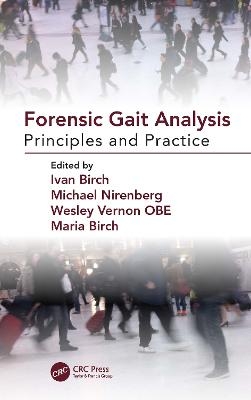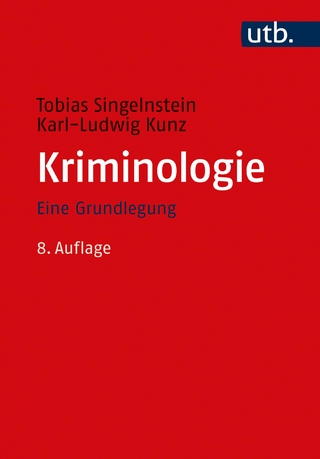
Forensic Gait Analysis
CRC Press (Verlag)
978-1-138-38684-6 (ISBN)
Gait analysis is the systematic study of human walking, using the eye and brain of experienced observers, augmented by instrumentation for measuring body movements, body mechanics, and the activity of the muscles. Since Aristotle’s work on gait analysis more than 2000 years ago, it has become an established clinical science used extensively in the healthcare and rehabilitation fields for diagnosis and treatment.
Forensic Gait Analysis details the more recent, and rapidly developing, use of gait analysis in the forensic sciences. The book considers the use of observational gait analysis, based on video recordings, to assist in the process of identification or exclusion. With the increase in use of CCTV and surveillance systems over the last 20 to 30 years, there has been a steady and rapid increase in the use of gait as evidence. Currently, gait analysis is widely used in the UK in criminal investigations, with increasing awareness of its potential use in the US, Europe, and globally.
The book details the history of the science, current practices, and of the emergent application to establish best-practice standards that conform to those of other forensic science disciplines. Engagement with the Forensic Science Regulator, and the Chartered Society of Forensic Sciences in the UK, and the International Association for Identification has helped to ensure and enhance the quality assurance of forensic gait analysis. However, there remains a fundamental lack of standardized training and methodology for use in evidentiary and investigative casework. This book fills that void, serving as one of the first to describe the current state of practice, capabilities and limitations, and to outline methods, standards of practice and expectations of the gait analyst as a forensic practitioner.
Forensic Gait Analysis reflects current research and forensic practice and will serve as a state-of-the-art guide to the use of gait analysis in the forensic context—for both education and training purposes. It will be a welcome addition to the libraries of professionals in the areas of podiatry, gait analysis, forensic video analysis, law enforcement, and legal practice.
Professor Ivan Birch is Consultant Expert Witness in forensic gait analysis with Sheffield Teaching Hospitals NHS Foundation Trust and Emeritus Professor of Human Sciences. Ivan graduated in 1978 with a BSc Joint Honours in Science from the University of Salford, gained an MSc in Human Biology from the University of Loughborough in 1980, and was awarded a PhD in Biomechanics by the University of Brighton in 2007. He has extensive experience of teaching biomechanics, anatomy, physiology and research methods, and is a Professional Member of the Chartered Society of Forensic Sciences. In 2015 he was awarded the status of the Chartered Scientist by the Science Council and College of Podiatry in the UK for his work in gait analysis as evidence. Ivan is included on the National Crime Agency Specialist Operations Centre Expert Witness Advisers Database in the UK, and has more than 35 years’ experience of gait analysis. Dr. Michael Nirenberg is a Board Certified podiatric physician and surgeon with over 25 years of experience in private practice. His long career of dedicated public service has included work as a podiatric surgical residency instructor to new podiatrists, lectures to the public on foot issues, and assisting law enforcement, including the FBI, with criminal investigations involving foot and gait evidence. Dr. Nirenberg’s forensic analysis of footwear and footprints has helped in the conviction of criminals. Currently, Dr. Nirenberg serves as President-Elect of the American Society of Forensic Podiatry. Professor Wesley Vernon OBE (Retired) Previously Head of Podiatry, Research Lead and Deputy AHP Lead, Sheffield Primary and Community Services, Past Visiting Professor Staffordshire University. Current Visiting Professor, University of Huddersfield. Fellow and past Chair of Quality Standards, Chartered Society of Forensic Sciences. Founding Fellow of the Faculty of Podiatric Medicine, the Royal College of Physicians and Surgeons of Glasgow. Fellow in Podiatric Medicine and of the Faculty of Management, College of Podiatrists. Meritorious Award holder of the Society of Chiropodists and Podiatrists. Distinguished Member, Dedication to Service Award holder and past Chair of the forensic podiatry Science and Practice committee, the International Association for Identification. Past President of the Society of Shoefitters. Authored/co-authored over 80 journal articles. Co-author of Forensic Podiatry: Principles and Methods, 1st and 2nd editions and contributor to Forensic Human Identification (eds Thompson and Black), 2007. Awarded OBE in 2009 for services to medicine and health care. Dr Maria Birch is a Principal Lecturer, and Deputy Head of the School of Health Sciences at the University of Brighton. She has been teaching students of the allied professions for 24 years, mainly lower limb anatomy and clinical podiatry. She has published work in forensic practice, arterial disease, and reflective practice. She has presented at national and international conferences on the student experience of learning anatomy, of the teaching and assessment of anatomy, and of the promotion of autonomous learning. She supports student research at BSc & MSc level, and peer reviews for four journals. She is a Senior Fellow of the Higher Education Academy, a Fellow of Podiatric Medicine with the College of Podiatry, and is registered with the Health and Care Professions Council.
1. Introduction 2. The History of the Use of Gait Analysis as Evidence 3. Fundamentals of Human Gait and Gait Analysis 4. The Legal Context of Forensic Gait Analysis 5. The Development of the Forensic Gait Analysis Quality Assurance Process in the UK 6. Initial Contact, Preliminary Assessment of Footage and Defining the Task 7. Analysing the Questioned and Reference Footage 8. Comparison of Gait and Evaluaiton 9. Writing Expert Witness Reports. 10 Presenting Gait Evidence in Court 11. Psychology of Perceptual Error in Forensic Practice 12 Probative Value of Gait Analysis 13 Case Studies Appendix Index
| Erscheinungsdatum | 09.07.2020 |
|---|---|
| Zusatzinfo | 7 Tables, black and white; 7 Line drawings, black and white; 7 Halftones, black and white; 14 Illustrations, black and white |
| Verlagsort | London |
| Sprache | englisch |
| Maße | 156 x 234 mm |
| Gewicht | 494 g |
| Themenwelt | Recht / Steuern ► Strafrecht ► Kriminologie |
| Technik | |
| ISBN-10 | 1-138-38684-7 / 1138386847 |
| ISBN-13 | 978-1-138-38684-6 / 9781138386846 |
| Zustand | Neuware |
| Haben Sie eine Frage zum Produkt? |
aus dem Bereich


